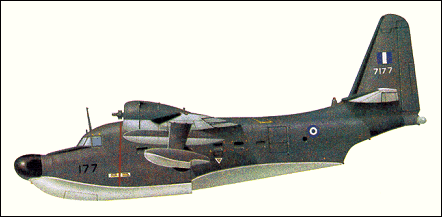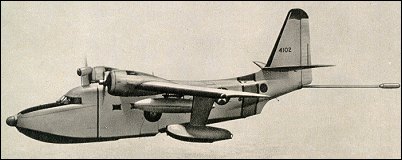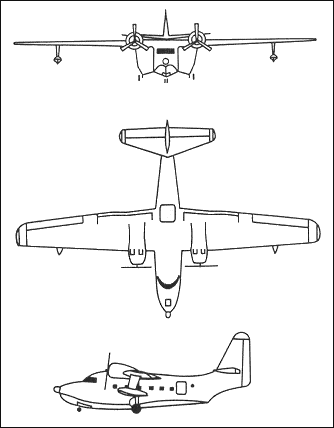|
| Experience with the Grumman Goose, which served throughout World War II with great reliability, prompted the US Navy to procure a somewhat larger amphibian with greater range capability. In 1944 the company initiated design of its Grumman G-64 aircraft, which was to be named Albatross, and which saw service with the US Air Force, US Coast Guard and US Navy. The prototype was flown first on 24 October 1947, and was of generally similar configuration to its predecessor. Fixed underwing floats were retained, but these and the entire structure had been considerably refined to reduce drag. Other changes included the provision of a cantilever, instead of strut-braced, tailplane; tricycle type retractable landing gear; and pylons beneath the wing, outboard of the engines, which could carry weapons, or drop-tanks to increase range. Additional fuel could also be carried in the underwing floats. Accommodation was provided for a crew of four and the cabin could accommodate 10 passengers, stretchers, or cargo, according to requirements.
The prototype ordered by the US Navy for service as a utility aircraft had the designation XJR2F-1, and flew for the first time on 24 October 1947. Initial production was of the UF-1 model, and a modified version introduced in 1955 was the UF-2. This latter aircraft had increased span, a cambered wing leading edge, ailerons and tail surfaces of increased area, and more effective de-icing boots for all aerofoil leading edges. In the tri-service rationalisation of designations in 1962, these aircraft became HU-16C and HU-16D respectively. Winterised aircraft for Antarctic service were designated UF-1L (later LU-16C), and five UF-1T dual-control trainers were rede-signated TU-16C.
The USAF found the G-64 attractive for rescue operations, the majority of the 305 ordered serving with the MATS Air Rescue Service under the designation SA-16A. An improved version, equivalent to the US Navy's UF-2, entered service in 1957 as the SA-16B; in 1962 these became HU-16A and HU-16B respectively. HU-16E was the designation (originally UF-1G) of Albatross aircraft operated by the US Coast Guard, and 10 supplied to Canada were designated CSR-110. An anti-submarine version with nose radome, retractable MAD gear, ECM radome and searchlight was introduced in 1961, and was equipped to carry a small number of depth charges. The versatile Albatross continues in service with a few air forces and navies, but its powerful and fuel-hungry engines have meant that surplus aircraft which became available for use were not a particularly attractive proposition to airline operators, and in consequence few were adapted for such a role.

| CREW | 2-4 |
| PASSENGERS | 10-22 |
| ENGINE | 2 x Wright R-1820-76A, 1050kW |
| WEIGHTS |
| Take-off weight | 14500-17000 kg | 31967 - 37479 lb |
| Empty weight | 10350 kg | 22818 lb |
| DIMENSIONS |
| Wingspan | 29.5 m | 97 ft 9 in |
| Length | 19.2 m | 63 ft 0 in |
| Height | 7.9 m | 26 ft 11 in |
| Wing area | 96.2 m2 | 1035.49 sq ft |
| PERFORMANCE |
| Max. speed | 379 km/h | 236 mph |
| Cruise speed | 360 km/h | 224 mph |
| Ceiling | 7600 m | 24950 ft |
| Range w/max.fuel | 5000 km | 3107 miles |
| ARMAMENT | bombs, missiles, torpedos |
| Dean Word, e-mail, 26.11.2011 06:03 I spent another fascinating Thanksgiving day with my father-in-law Bill Edge listening to stories. He was a 50 mission 8th AF B-17 pilot who took delivery of the very first Guppy from Grumman. After checkout, he delivered it to Tampa, Fl where he an 2 others logged 146 water takeoff /landings over 3 days.
He carried Lt. Gen Robert E. Lee to 3 islands on one ahead of the first H-bomb test. One takeoff required rocket assist from the overgrown and collapsed runway, which had stuck the right main gear on landing. reply | | Jack Hoyt, e-mail, 25.10.2011 23:59 In 1954 - 1956 I flew as A /C in the 56th ARS at Sidi Slimane, Morocco. Any "alumni" of that squadron during those years please post a comment. reply | | Richard R. Casey (AT-2), e-mail, 11.10.2011 22:57 Was stationed on Kwajalein, M.I. from 1955-1956 doing SAR duty with a squadron of UF's. Our plane (137928) as TDY'd to Eniwetok by Rear Adm. Hanlin during Operation Redwing for his secondary plane to fly from Eniwetok to Bikini and the surrounding island to witness and view A-Bomb distruction sites. Was present during the H-Bomb drop off Bikini in 1956. Left Eniwetok after suffering radiation poisoning and returned to Kwajalein. Also spent a lot of time doing SAR at Wake Island. Loved that aircraft. My next duty station was with VP-42 at North Island, San Diego. Left active duty in 1958, but never the Navy. Became an Aerospace Engineer and spent many years working on Navy projects. Retired from DCMA(DOD)in 2006 and now live in St. Petersburg, FL. reply | | Jerry Bethke, e-mail, 09.10.2011 20:50 I flew the UF-1 off NS MIDWAY in 1957 and 58. I was a ADR3Plane capt. at that time we had 4 aircraft the Bu #131890 131904 131905 131924 I had time in all four My pilot was LtCDR Bill Fitzsimmons Those days were a lot of fun reply | |
| | william Sweet, e-mail, 08.10.2011 20:29 I was stationed at Hickham AFB in Hawaii for 3 1 /2 years in Squadran ASR 47. We had 4 SB-17's and 4 SB-29's which I flew in as a Crewchief. We lost our SB-17"s in 1951 and got 4 SB-16A's, the first one was tail number 1714 which I flew in all over the Pacific for 3 years. Many Jato take offs lots of fun. We took 2 SA16's to Entwtok for the first H-Bomb tests spent 3 months there flying from island to island picking up filters to check radio activity. reply | | Harold Bratton, e-mail, 02.09.2011 00:22 Was stationed at ECity AR&SC form Nov 1968 to Feb 1972.
Mainly worked on 52's but spent some time with the goats.
Remember high speed water taxies after overhaul. Checking
for water leaks. Did these with no floorboards and a bunch
of folks in the hull with flashlights. On one of these
we had lots of wind. When we turned to come back to the
seaplane ramp we ended up with one wing in the water
up to the engine. Water ran out of that wing for a couple
of days. Wonder it that added to the corosion problems??? reply | | Harry "JUG" Jones, e-mail, 24.08.2011 18:03 I flew this A /C in 1952 in the 580th ARS at Mt. Home AFB. This was an extraordinary short field A /C when JATO was used. Able to operate in and out in 500 ft. of "runway". reply | | George Simon, e-mail, 10.08.2011 07:41 1950-51 A /C mechanic = 13 months @ BW-1 Narsarsuak,Greenland and in 1952-53 Flt Engr 51st ARS....
Please NOTE Correction in e-mail the dash instead of =... Over 1300 hours flt hrs in the Albatross. reply | | George Simon, e-mail, 10.08.2011 07:24 I severed a 13 month tour as an A /C mechanic. Went bac in 1952-53 as a flight engineer assinged to the 51st ARS IN Narssauak, Greenland, BW-1. If it weren't for the loud noise it was a great plane to fly in. Landed on the ice-cap once and visited several Esikmo villages, the scenery was awesome. Also served with the 52nd ARS in Goose Bay, Labrador, a much bette duty station, close to Halifax, Nova Scotia where I would take my R&R. Duck Butted alot of Jets coming from the USA heading to Europe. Lost 4 F-86's at one time. Powered Milk, Eggs, etc., was something hard to get used to. Two 13 month tours in an ISOLATED area was also pretty tough to handle. Got my training in West Palm Beach, Florida.. Good ole Lake Okechobee. sp reply | | PAUL M. STEUBE, e-mail, 08.08.2011 07:57 I flew the Albatross out of NAS Agana, Guam,1966-68. I've come to the point in life when I feel like indulging myself. I'm having a company build me models of the 8 aircraft I flew in the Navy. They need a picture or diagram showing the JATO bottles mounted. Does anyone have any such pictures? reply | | Jack Hoyt, e-mail, 05.07.2011 23:36 Any "alumni" of the 56th Air Rescue Squadron at Sidi Slimane, Morocco from the mid fifties still around? It would be interesting to hear from you. reply | | butch, e-mail, 14.06.2011 22:17 I too was a goat herder plane captain at Air Station Cape Cod for 3 1 /2 yrs. 73-76. Like another rider said, you could fly for hours and move about 10 feet. sad to see the old girl go but such is the life of an airplane. Can't all be like the B-52 and last forever, or so it seems.. Actually was a great little plane. Could take a lot of abuse and still fly. Amazing. reply | | Neptune, e-mail, 27.05.2011 04:38 I Bet it was 120FB. That was the only one I have seen painted in the 1990's Chalks paint scheme. It sadly crashed in florida recently. reply | | Neptune, e-mail, 21.05.2011 18:20 I saw a Chalks Albatross working in Nassau in about 1993 or 1994. There was only one flying along side the Turbo mallard's. I asked around and a hotel employee said the were testing to maybe bring them back into the fleet. Does anybody know why the spent all the money to make them G-111, and then stopped flying them in the 1980's. How long were they operational in the 1980's. Where they having engine failures? reply | |
| | Steve Vansant, e-mail, 15.04.2011 06:39 I overhauled Goats at USCG AR&SC 1968 to 1970. Lots of test flights on newly overhauled A /C. I then went to Air Station New Orleans. I got out in 1971. After 31 years as a firefighter in So. Cal. I am once again a goat herder at March Field Air Museum in Riverside, Ca. We have USCG 1293 on display. reply | | Ken Allen, e-mail, 29.03.2011 03:07 In 1963 I qualified on the Albatross on NS Midway Islands and flew many Searches and duck butt missions. Have many hours in the plane. I was ADR-1 at the time. Made one emergency water landing.Landing gear was screwed up.Very good bird. reply | | Ed Hickey, e-mail, 20.03.2011 07:20 Flew on BUNO 137910 at NAF Lajes, Azores, 1959-1960 as radio and radar operator. Some hairy water landings but most flights were to Santa Maria island to drop off or pick up passengers as our Albatros wss fitted out nicely for passenger duty. Believe that 137910 was a former Coast Guard bird that was refurbished prior to our getting it. reply | | Dave Williams, e-mail, 13.03.2011 20:30 Flew the HU-16 at Goose Bay, Labrador from 1971 to 1975. Many water experiences with DC bigwigs. Could not believe the USAF paid me for so much fun. A few rescues in between ferrying dignataries to survival (fish camps)was challenging but gratifying. Great airplane. reply |
| Ron Norton, e-mail, 08.03.2011 05:38 I was a plane capt. on the UF at NAS Annapolis from April 1958 to April 1959. At the time I was stationed there most of the flight time was for the Acadamy Pilots. Numerous trips to various places for their flight time. I can still remember how many cases of whiskey can be stored in the hull under the floor boards coming out of Bermuda. Had a great time while at Annapolis. Remember we had a good flag football team, just couldn't beat the marines on the base. I would like to hear from anyone that was stationed there during that time frame. reply | | Harold Jaffe, e-mail, 24.02.2011 14:45 I flew a SA 16 out of Burtonwood AFB in 1952&1953 with the 68th Air Rescue 9th group and stood watch at Prestwick Scotland with it. Plus Holland floods & Greek earthquake, and varios other missions for downed planes. Did over a 100 open sea landings with it. Great plane for water landings reply |
|
Do you have any comments?
|
| 
COMPANY
PROFILE
All the World's Rotorcraft
|









my dad Randall J Thomas was crew chief on hu-16 i think from 1971 to 1973 i would like some pictures of his plane to build a rc model
reply